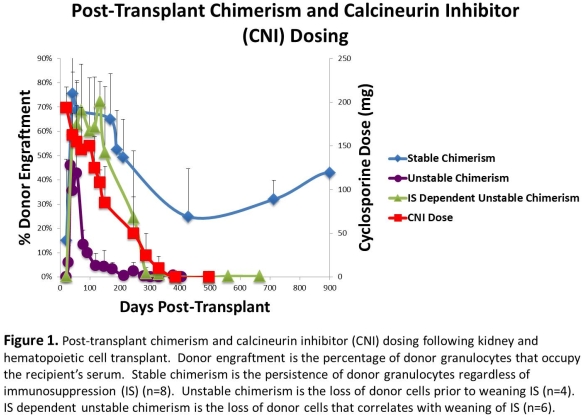Stable and Unstable Chimerism During Immunosuppressive Drug Withdrawal in Tolerant Recipients of HLA Matched Combined Kidney and Hematopoietic Cell Transplants
1Surgery, Stanford University, Palo Alto, CA
2Medicine, Stanford University, Palo Alto, CA.
Meeting: 2015 American Transplant Congress
Abstract number: 236
Keywords: Immunosuppression, Kidney transplantation, Stem cells, Tolerance
Session Information
Session Name: Concurrent Session: Tolerance: Clinical Studies
Session Type: Concurrent Session
Date: Monday, May 4, 2015
Session Time: 2:15pm-3:45pm
 Presentation Time: 2:39pm-2:51pm
Presentation Time: 2:39pm-2:51pm
Location: Room 122-AB
Our previous studies showed that 75-80% of HLA matched recipients of combined kidney and hematopoietic cell transplants conditioned with total lymphoid irradiation (TLI) and anti-thymocyte globulin (ATG) developed tolerance, and had no rejection episodes after immunosuppressive (IS) drug discontinuation for up to 5 years thereafter. Tolerant patients had detectable mixed chimerism for 12 months after administration of mycophenolate mofetil for1 month and a tapering course of calcineurin inhibitor (CNI) starting at 6 months. In the current study, we determined the chimerism of granulocytes and T cells and compared this to the dose of CNI before, during, and after the withdrawal of the CNI in 18 patients. We found 3 patterns; one in which the peak granulocyte chimerism levels were unstable and declined to< 10% before tapering the CNI to subtherapeutic levels, a second in which the peak granulocyte levels were unstable and declined to <10% associated with tapering to subtheraputic levels, and a third in which peak granulocyte levels were stable and maintained at >10% during tapering to subtherapeutic levels and after CNI discontinuation (Figure 1). All 3 groups developed tolerance. Patients in the first group with decline before taper, all had peak early levels of granulocyte chimerism <65% during the first 60 days as did 2 patients in the second unstable group. Four patients in the second group, and all patients in the third group had peak early levels >65%. Seven of 8 patients in the third group with stable chimerism after CNI discontinuation had a gradual increase in T cell chimerism to >10% by 250 days. Four of 6 patients who lost chimerism after CNI discontinuation had <10% T cell chimerism by 250 days. In conclusion, early and late chimerism levels in granulocytes and T cells may be useful predictors of stability of mixed chimerism in HLA matched recipients before, during, and after IS drug withdrawal. We are currently determining the utility of these predictors in HLA mismatched patients.
To cite this abstract in AMA style:
Pham T, Busque S, Scandling J, Shizuru J, Asha S, Strober S. Stable and Unstable Chimerism During Immunosuppressive Drug Withdrawal in Tolerant Recipients of HLA Matched Combined Kidney and Hematopoietic Cell Transplants [abstract]. Am J Transplant. 2015; 15 (suppl 3). https://atcmeetingabstracts.com/abstract/stable-and-unstable-chimerism-during-immunosuppressive-drug-withdrawal-in-tolerant-recipients-of-hla-matched-combined-kidney-and-hematopoietic-cell-transplants/. Accessed December 21, 2025.« Back to 2015 American Transplant Congress
